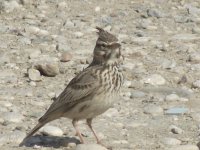I agree entirely John! Here is a bit I wrote on the other forum - my musings on habitat preferences for this pair...I think Crested's shunning of stony soils is reflected in its less robust bill
"Just a couple of thoughts from the perspective of seeing this problematic pair all the time during the last 28 years. (They are also a favourite of mine - endearing, full of character and approachable). In 2009 I spent 7 weeks in the northern Baixo Alentejo on a breeding bird survey. I covered 400 1km squares using systematic and timed techniques on all breeding species. Close to 100 squares were surveyed twice with extra data collection for Greater Short-toed lark, Calandra Lark,Tawny Pipit and Black-eared Wheatear. I paid special attention to Crested and Thekla Larks - both of which were present in many squares with one or the other pretty evenly distributed in the remainder. They were occasionally breeding close to each other with apparent adjacent territories, although in distinct habitats. Detailed notes were taken on the habitats.
Habitat - Of course its not wise to identify birds on habitat alone but it can be an excellent indicator in favour of or another species. I think this pretty reliable in Thekla/Crested ID. They are both some of the most sedentary species in Iberia. My experiences of their habitat preferences are:
Pro Thekla
Rocky or stony soil with stones larger than about 1cm diameter.
Presence of shrubs from about 20cm to over 1m and can include some trees usually oaks (Cork and Holm Oak) or Pines (Stone and Maritime)
Percentage of woody vegetation cover sparse to 100% - usually scrub.
In areas with high cover they can be on sandy soils, fixed dunes and heaths etc.
Some bare ground at least - tracks are sufficient.
Habitats usually covering large or very large areas with low human impact.
Pro Crested
Fine soils or sand
Sand dunes, Dry saltmarsh edges and humanised habitats like farmland, dusty car parks and tracks.
Percentage of woody vegetation cover usually very low and including substantial amount of bare ground. Can be near trees, these often Olive, Figs, Citrus, Carob or Almond.
Often occurring in small niches of suitable habitats.
Hybrids - I know of no documentation of hybridization between Thekla and Crested Lark. I hardly ever hear of this possibility being considered either. Anyone help on this matter?
Personally I find I can normally satisfyingly separate the two with a reasonably good view. Apart from visual characters discussed Theklas are a "compact" slightly rotund creature - in a way between Crested and Woodlark but nearer Crested. The wash of chestnut on the rump is easier to see than the underwing colour - but its worth trying to see. On occasions I wonder about hybrids - maybe at the few areas with an overlap in habitat.
In an Algarve context Thekla occupies more 10X10kms squares than Crested Lark, which is by far the commonest of the two in coastal areas near people. That, I believe can often give the impression of Crested being the most abundant. My impression is that there must be 2 or 3 Theklas for every Crested over the whole Algarve. Theklas are by far the commonest of the two once you get about 5 - 10kms north of the south coast".
Simon
http://algarvebirdman.com/




